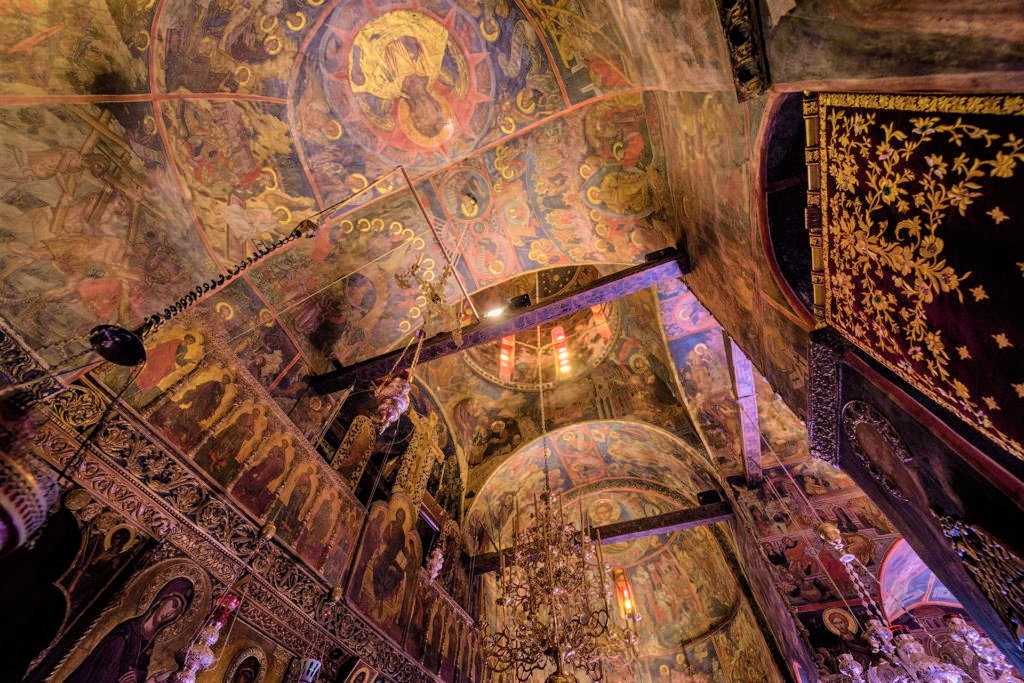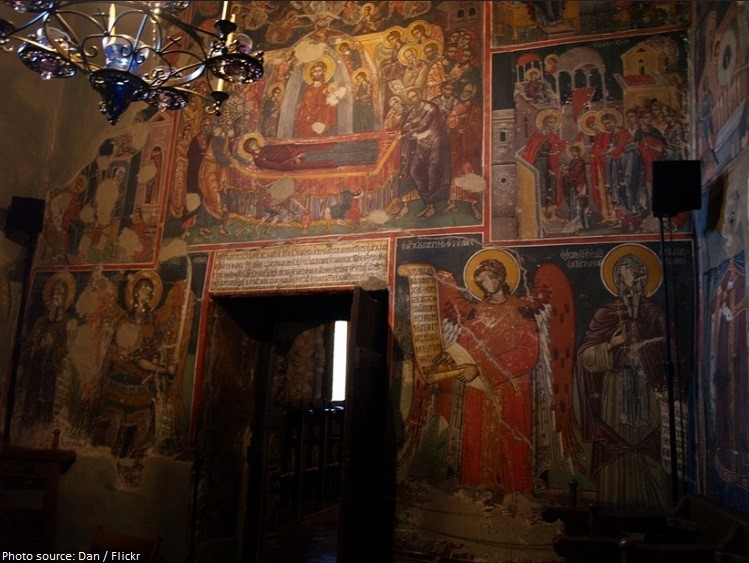This first icon in the antechamber depicts the spirit-fighting church in a very special moment, in the border between the present and the future life.

Imagine martyrdom, mostly in the time of the Romans. Some of them were so cruel that even the sickest human imagination counts them as sick, martyrdom, suffered by the church. Among them, a saint being skinned off alive, saints being grilled, another being boiled alive, another beheaded, thrown to death, water, a saint being crucified upside down and beside him another saint beheaded with some heads scattered around. Do you remember somebody who was crucified upside down? Peter, according to church tradition. And Paul was beheaded, being a Roman citizen. So, in this chamber, the antechamber of the narthex, we saw the spirit-fighting church depicted.
We walked inside the main room of the Church in Varlaam and faced the door. Kostos pointed up for us to see the crucifixion, and the sleep of Mary.
In the icon of the crucifixion, we saw Jesus on the cross (in the middle) and, on both sides, the 2 thieves. See the group of the women on the left and see John the Disciple? Mary and John have halos. On the right side do you see a Roman soldier coming also with a halo? How is that possible?

On the side of the arms of Jesus see 2 spots, each with a face inside. The one on the right is grey and the one on the left is red. These depict the representatives of the material creation. The red one is the sun and the grey one, on the right, is the moon. They both look to the Creator. They are shocked; They run the races. This Is why you see the light hair blown by the wheat in front of their faces/ Yet these are the races that brought down. So then there was, for three hours, a total darkness over the earth.
Now I would like tell you about a detail related to the cross. Below the cross of Jesus, inside this cave is the skull of somebody and some bones. A little thing. Take a guess. Whose skull is this? Adam. Yes, Adam’s head. Remember Adam, with his life up disobedience, brought death to the whole human race and Jesus according to Pauline theology, (the theology of the Apostle Paul, Romans 5:12-21) The last Adam brought life to the human race with his death of obedience. So, they have depicted both the Adams, the first and the last one.
The second icon was an icon that marks a theological difference with the Catholic church. In the Catholic Church they speak about the ascension of Mary. They say that Mary was brought to Ephesus and from a house there sent to the heavens and so she never died.
So, in this icon you see Mary in her burial bed and Jesus is receiving an infant.


But if you go to Jerusalem the Orthodox Church points close to the garden of Gethsemane, the Church of the Mission, and inside there you can see the grave of Mary. The eastern church does not speak about the ascension of Mary but about the sleep of Mary. Here is an enlarged picture of the icon.

This is the only time when we see Jesus holding an infant (usually we see Mary holding the infant Jesus.) This is the soul of Mary; the soul departed from the body and embraced in the bosom of Jesus. Now she is depicted as an infant to show that although Jesus was her son, at the same time, He was her creator as well.
Kostos pointed out another icon, and you will need to imagine this one, as I didn’t find a picture of it. I would like us briefly also to “see” an icon on an arch.
Very briefly, we see the resurrection being depicted. The Catholic Church depicts the resurrection by showing Jesus coming out from the grave, an empty grave (something that never somebody saw because we know from the Bible that when the first witnesses went out to the grave the grave was already empty.) But the Eastern church depicts the resurrection starting from a deeper place – from the Kingdom of Hades.
You see Jesus stepping upon the broken panels of Hades gates. He is in a glory (imagine the grey blue shade above and behind him depicts His glory; Jesus comes down from Hades after He has broken the gates of Hades. And you see an angel chasing the defeated enemy, this dark figure, poised, is Hades Himself.
Remember, when Jesus introduced the church in Matthews gospel? (Matthew 16:18) Jesus said, I am going to build my church on this rock and the Gates of Hades will not prevail on it.
Actually, translating the name Hades as Hell is a total mistake. Hades at the time of Jesus and forthcoming years after Him, for all the people of the Mediterranean world, was the name of a Greek god. Not a situation. Not hell, like in many English translations it is translated.
So the King of Death, the Ruler of the Underworld, is defeated and the angel is chasing him.
Remember also, in the Book of Revelation (Revelation 20:14) the Apostle John says, In the last day Death, the personality, and Hades, as a personality, are going to be chained and thrown in the Lake of Fire.
You see Jesus coming down from the Kingdom of Hades drudging out of the graves an old couple, these are the forefathers of humanity, Adam and Eve.
Again, here we have the theology of the Apostle Paul who said that As through one person, death came to everybody, the same way, through one person, Jesus life and resurrection will come to everybody. (1 Corinthians 15.)
So, in the icon we are reading, do you see, can you imagine, that the representatives of the human race are taken out of their graves? Behind Adam you see some people with crowns. These are the Kings of Israel, pointing to Jesus, and on the other side you see the representatives of the Gentiles also pointing and looking to Jesus. Among the representatives of the Gentiles, we see Abel, the first righteous, who was killed by his brother. We see Melchizedek, the chief priest of the Most High God, and also Noah. So we could say a lot.
Look here, imagine also, the assembly the cross, You see Jesus using a ladder to ascend on the cross and possibly you wonder if the painter knew the actual and historical circumstances of the crucifixion. Because definitely, somebody couldn’t be crucified using a ladder.
My question is Do you know somebody else outside of the Bible who was crucified, who was a famous historic personality?
Have you heard the name Spartacus? Who was Spartacus? Spartacus was a defeated, rebellious slave and Himself together with His 3000 followers were all crucified. Was Jesus like Spartacus, a defeated rebellious slave? He died as a slave, but was he like Spartacus? No. Jesus willingly ascended to the cross and this is why you see the ladder there. Jesus offered Himself to become the sacrifice.
We could say a lot of things but there were other groups waiting in the hallway. Let’s continue outside to see the other environments of this monastic move.





